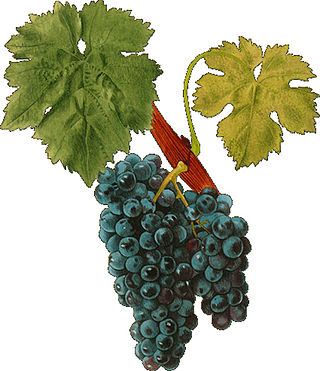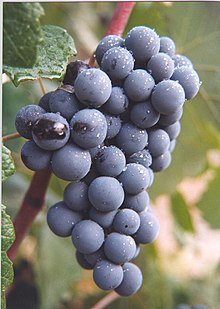
Merlot is a dark blue–colored wine grape variety, that is used as both a blending grape and for varietal wines. The name Merlot is thought to be a diminutive of merle, the French name for the blackbird, probably a reference to the color of the grape. Its softness and "fleshiness," combined with its earlier ripening, make Merlot a popular grape for blending with the sterner, later-ripening Cabernet Sauvignon, which tends to be higher in tannin.

Carignan is a red grape variety of Spanish origin that is more commonly found in French wine but is widely planted throughout the western Mediterranean and around the globe. Along with Aramon, it was considered one of the main grapes responsible for France's wine lake and was a substantial producer in jug wine production in California's Central Valley but in recent years, it has been reborn as a flagship wine for many cellars in the south of France as well as in Catalonia.

Barbera is a red Italian wine grape variety that, as of 2000, was the third most-planted red grape variety in Italy. It produces good yields and is known for deep color, full body, low tannins and high levels of acidity.

Pinot Meunier, pronounced[pi.nomø.nje], also known as Meunier or Schwarzriesling, is a variety of red wine grape most noted for being one of the three main varieties used in the production of Champagne. Until recently, producers in Champagne generally did not acknowledge Pinot Meunier, preferring to emphasise the use of the other noble varieties, but now Pinot Meunier is gaining recognition for the body and richness it contributes to Champagne. Pinot Meunier is approximately one-third of all the grapes planted in Champagne. It is a chimeric mutation of Pinot: its inner cell layers are composed of a Pinot genotype which is close to Pinot noir or Pinot gris; the outer, epidermal, layer is, however, made up of a mutant, distinctive, genotype. Pinot Meunier was first mentioned in the 16th century, and gets its name and synonyms from flour-like dusty white down on the underside of its leaves.

Tempranillo is a black grape variety widely grown to make full-bodied red wines in its native Spain. Its name is the diminutive of the Spanish temprano ("early"), a reference to the fact that it ripens several weeks earlier than most Spanish red grapes. Tempranillo has been grown on the Iberian Peninsula since the time of Phoenician settlements. It is the main grape used in Rioja, and is often referred to as Spain's noble grape. The grape has been planted throughout the globe's wine regions.

Aligoté is a white grape used to make dry white wines, especially in the Burgundy region of France where it was first recorded in the 18th century. Since it is tolerant to cold, this variety is also cultivated in Eastern European countries. In 2004, it was the 22nd most planted vine variety in the world at 45,000 hectares.

Airén is a variety of Vitis vinifera, a white grape commonly used in winemaking. This grape is native to Spain where it represents almost a quarter of all grapes grown. As of 2010, Airén was estimated to be the world's 3rd most grown grape variety in terms of planted surface, at 252,000 hectares, down from 306,000 hectares in 2004, where it held 1st place, although it is almost exclusively found in Spain. Since Airén tends to be planted at a low density, several other varieties are more planted in terms of number of vines.

Mourvèdre is a red wine grape variety grown in many regions around the world including the Rhône and Provence regions of France, the Valencia and Jumilla and Yecla denominaciones de origen (DOs) of Spain, as well as the Balearic Islands, California and Washington and the Australian regions of South Australia and New South Wales, plus South Africa. In addition to making red varietal wines, Mourvèdre is a prominent component in "GSM" blends. The variety is also used to make rosé and port-style fortified wines.

Valencian cuisine is a Mediterranean cuisine as cooked in the Valencian Community, Spain. Its basic ingredients are vegetables, seafood and meat. It is famous worldwide for its rices, such as paella, and its citrus fruits. The cuisine of neighbouring regions have given and received important contributions from Valencian gastronomy, amongst them Balearic cuisine, Catalan cuisine, Aragonese cuisine, Manchego cuisine and Murcian cuisine.

Spanish wine includes red, white, and sparkling wines produced throughout the country. Located on the Iberian Peninsula, Spain has over 1.2 million hectares planted in wine grapes, making it the most widely planted wine-producing nation, but the second largest producer of wine in the world, behind Italy and ahead of France and the United States. This is due, in part, to the very low yields and wide spacing of the old vines planted on the dry soils found in some of the Spanish wine regions. The country is ninth in worldwide consumption with Spaniards drinking, on average, 21.6 litres per person a year. The country has an abundance of native grape varieties, with over 400 varieties planted throughout Spain, though 88 percent of the country's wine production is from only 20 grapes — including the reds Tempranillo, Bobal, Garnacha, and Monastrell; the whites Albariño, Airén, Verdejo, Palomino, and Macabeo; and the three Cava grapes Parellada, Xarel·lo, and Macabeo.
Raboso is a red wine grape grown primarily in the eastern part of Veneto. It is also called Raboso Piave, from the name of a river near where it is grown. It produces deep-colored wine, with notably high levels of tannin and medium alcohol content and high acid. The name raboxo in the native Venetian language means "angry", because angry is the sensation in the mouth when this wine is drunk young. Raboso was in the past the most cultivated grape variety of eastern Veneto; Venetian navigators called it vin de viajo, "wine of travel", because it was the most resistant to aging and transport. Its popularity decreased in the 20th century, and today the vineyards of Raboxo are just 1–2% of the total amount of vineyards in Veneto.

Utiel Requena is a Spanish Denominación de Origen Protegida (DOP) for wines located in the province of Valencia. It takes its name from the two neighbouring towns of Utiel and Requena. It is renowned for the predominant use of the Bobal grape variety.
This glossary of viticultural terms list some of terms and definitions involved in growing grapes for use in winemaking.

Santorini is a Greek wine region located on the archipelago of Santorini in the southern Cyclades islands of Greece. Wine has been produced there since ancient times, but it was during the Middle Ages that the wine of Santorini became famous worldwide under the influence of the Republic of Venice. The Italian influence is still present in modern Santorini winemaking: the most famous Tuscan sweet wine is called Vin Santo just like Santorini's Vinsanto/Visanto. It is made in a passito style from grapes dried in the sun after harvest.

Tempranillo blanco is a white Spanish wine grape variety that is grown in the Rioja Denominación de Origen (DOC). It is a mutation of the red Tempranillo grape variety that is planted in Rioja. The white grape variety was discovered in a Tempranillo vineyard in the Rioja region by a wine grower in the late 20th century. In 2007, the Consejo Regulador of Rioja officially sanctioned the use of Tempranillo blanco in the DOC wines of Rioja.
Bodegas Vicente Gandia , is a Valencian wine producer and seller company founded in 1885. Hoya de Cadenas, its family-owned estate, is located in Utiel, Spain. The cellar produces and sells wines from different appellations of Origin including Utiel-Requena, Valencia, Alicante, Rioja, Ribera del Duero, Rías Baixas, Rueda and cava.
Forcallat tinta is a red Spanish wine grape variety that is native to the Castile-La Mancha region of central Spain, as well as in Alicante and Valencia provinces in the Valencian Community. The name of the cultivar means "forked" in Valencian, which probably refers to the bunches having a wing or shoulder, rather than a tendency to produce forked vines as suggested by Favà. It tends to produce pale-colored wines and is most often used as a minor blending component in Vino de la Tierra (VdlT) wines. It is an authorized variety in the Comunitat Valenciana, where it has become almost extinct and only a few wine makers like Rafael Cambra are making efforts to recover it, with interesting proposals like La forcallà d'Antònia. Extant plots are found in Fontanars dels Alforins, La Font de la Figuera, Villena and probably Moixent, though the cultivar was once a prevailing one in La Vall d'Albaida and Alto Vinalopó regions. Bodega la Encina in Villena (Alicante) with vineyards in neighbouring Almansa (Albacete) also works with the variety, offering wines from biodynamic and organic farming. DNA profiling conducted in the early 21st century determined that the white berried Forcallat blanca grape is a distinct variety and not a color mutation of Forcallat tinta. The white cultivar Trepadell is also called Forcallat blanc in the village of La Font de la Figuera, with only one remaining plot of about 600 plants. Trepadell is also present in the Marina Alta region and has been elaborated by Curii uvas & vinos.
Manto negro is a red Spanish wine grape variety grown on the Balearic islands. It is used in wines produced under the Binissalem-Mallorca and Plà i Llevant (DO) Denominación de Origen (DO)s, as well as the Illes Balears appellations. Today, Manto negro is almost exclusively found on the island of Majorca with 320 hectares, making it the most widely planted grape variety on the island. It represents over 20% of the total vineyard land in production. Although planted throughout the island, the vine seems to be more successful in the rocky soils of the western Binissalem region.

Valencia, natively also València, is a province of Spain, in the central part of the autonomous Valencian Community. Of the province's over 2.5 million people (2018), one-third live in the capital, Valencia, which is also the capital of the autonomous community and the 3rd biggest city in Spain, with a metropolitan area of 2,522,383 people it is also one of the most populated cities of Southern Europe. There are 265 municipalities in the province.















